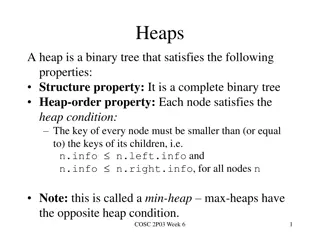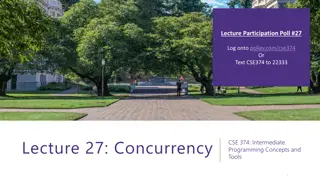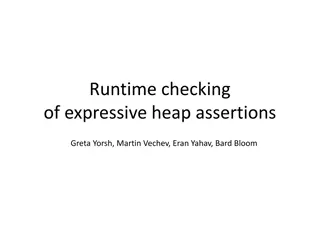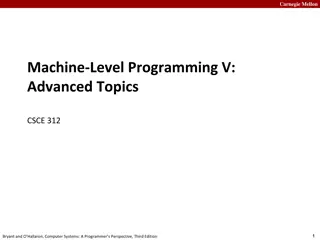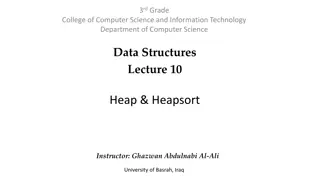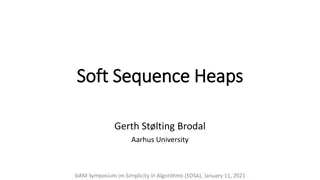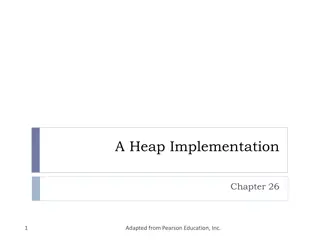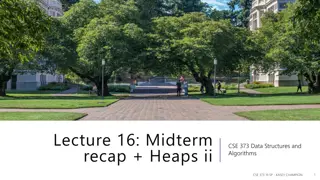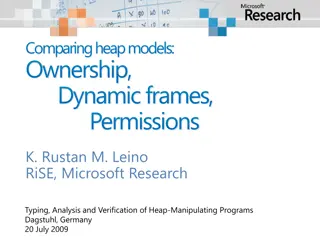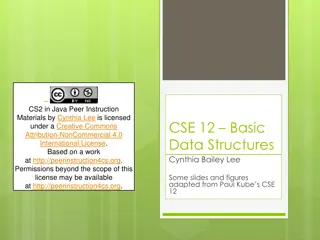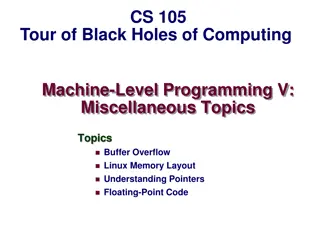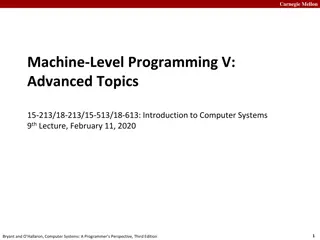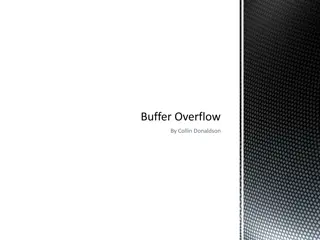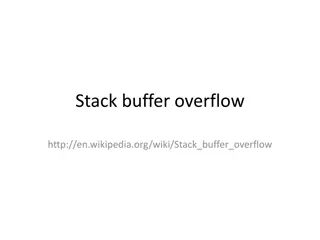Understanding Memory Management in Computer Systems
Explore Carnegie Mellon University's concepts on heap management and memory allocation strategies as detailed in "Computer Systems: A Programmer's Perspective." Dive into topics such as extending the heap, free blocks, and common problems with throughput and memory utilization.
0 views • 21 slides
Understanding Buffer Overflow Attacks at Carnegie Mellon
Learn about the Carnegie Mellon 15-213 Recitation Attack Lab, where you can hijack programs using buffer overflow attacks. Gain insights into stack discipline, stack frames, and defeating secure programs through return-oriented programming. Dive into topics like stack smashing attacks, buffer overfl
8 views • 24 slides
Understanding Heaps in Binary Trees
Heaps are binary trees that adhere to specific properties, such as being complete and satisfying the heap-order property. This involves nodes having keys smaller than or equal to their children. Key operations like removeMin and insert can be performed on heaps efficiently. Array implementations all
0 views • 10 slides
Understanding Buffer Overflow Vulnerabilities in Programming
Buffer overflow vulnerabilities pose serious security threats by allowing attackers to execute arbitrary code on victim machines. This issue arises from overwriting memory in a way that manipulates the program's behavior. Learn about the dangers of buffer overflow bugs, how they can be exploited, an
2 views • 33 slides
Runtime Checking of Expressive Heap Assertions
Motivated by the unreliability of large software systems due to concurrency bugs and limitations of static analysis, the goal is to enable runtime analysis of deep semantic properties with low overhead. This involves checking expressive heap assertions at runtime with minimal impact on performance,
0 views • 15 slides
Buffer Overflow: Understanding, Defenses, and Detection
Dive into the world of buffer overflow attacks with insights on understanding the concept, implementing defenses, and detecting stack smashing using techniques like canary values. Discover how to protect against vulnerabilities and grasp the significance of elements such as EIP, ASLR, DEP, and NX bi
0 views • 10 slides
Understanding Memory Layout in Computer Systems at Carnegie Mellon
Explore the memory layout in computer systems through the lens of Carnegie Mellon University's advanced topics in machine-level programming. Learn about buffer overflow vulnerability protection, memory allocation examples, x86-64 Linux memory layout, and addressing schemes. Dive into practical examp
2 views • 47 slides
Data Structures and Heaps in Computer Science - Lecture 10 Overview
Explore the concept of heaps and heapsort in data structures, focusing on the binary heap data structure as an array object that resembles a nearly complete binary tree. Learn about binary tree representations, heap properties, and vertex assignments in a linear array to enhance search efficiency. U
1 views • 33 slides
Soft Heap and Soft Sequence Heaps: Properties and Applications
Explore the properties and applications of Soft Heap and Soft Sequence Heaps, discussing how corruption handling and selection functions are optimized in these data structures. The concept of car-pooling and the simplification of heap operations are highlighted, along with references to relevant res
1 views • 10 slides
Overview of Soft Sequence Heaps in Algorithms
Soft sequence heaps are a specialized data structure designed to handle corruptions in heap operations efficiently. This technology, introduced at Aarhus University, simplifies heap manipulation, particularly in car-pooling and other applications, with a focus on minimizing corruptions during extrac
0 views • 10 slides
Understanding Heap Sort in Data Structures
Heap Sort, a sorting algorithm based on the concept of a heap data structure, is explained in detail. The properties of a heap, its implementation using a complete binary tree, and its application in priority queues are discussed. The process of building a heap, inserting elements, and sorting them
0 views • 7 slides
Understanding Heap Overflows: An Introduction to Exploit Development
Learn about heap overflows in exploit development, including heap structure, memory maps, exploiting vulnerabilities, and controlling writes in the heap. Understand the difference between stack and heap, viewing heap in gdb, targeted exploit techniques, and the challenges of controlling EIP in the h
0 views • 17 slides
Understanding Priority Queues and Heap Data Structures
Priority queues play a key role in computer science algorithms by managing data based on priority levels. The use of heap data structures enhances the efficiency of priority queue operations. This tutorial covers the basics of priority queues, their applications, different implementations such as li
0 views • 30 slides
Abstract Domains for Lists and Heap Structures: A Comprehensive Overview
Explore the concepts of quantified data automata on skinny trees, automatic shapes in static analysis, universally quantified properties on lists, heap configurations with skinny trees, and the extension of quantified data automata over lists. Dive into the abstract domain of automata to capture inf
1 views • 20 slides
Heapsort and Heaps: A Generic Algorithm for Sorting
This content discusses the concept of heapsort and heaps in the context of sorting algorithms. It covers a generic algorithm for sorting a sequence of numbers in non-decreasing order, detailing different implementations and time requirements for inserting and removing elements from a set. A clever c
0 views • 50 slides
Understanding Heap Data Structure Implementation
Explore the implementation of a heap data structure through a complete binary tree concept, array representation, adding elements, removing elements, and avoiding swaps. Learn the steps involved in adding, removing, and organizing elements within a heap for efficient data storage and retrieval.
0 views • 17 slides
Understanding Heap Sort and Binary Search Tree Concepts
Learn about Heap Sort for sorting elements in ascending or descending order, Priority Queue as a data structure supporting key operations, Binary Trees with recursive definitions, and exercises involving priority queue operations. Explore the concepts through visual aids and examples provided in the
0 views • 18 slides
Understanding Heap Overflow Attacks
A heap is a collection of variable-size memory chunks managed by the program. Heap overflow attacks occur when malicious actors corrupt heap memory, potentially allowing them to overwrite data and execute arbitrary code. This poses a significant security risk. The process involves manipulating heap
2 views • 19 slides
Implementing Heaps: Node Operations and Runtime Analysis
Understanding the implementation of heaps involves knowing various node operations like finding the minimum node, last node, next open space, children, and parent. The runtime analysis of heap operations such as peekMin, removeMin, and insert are crucial for optimizing performance. This recap covers
0 views • 9 slides
Understanding Priority Queues and Heaps in CSE 373 Lecture
Today's lecture in CSE 373 covers the Priority Queue Abstract Data Type (ADT), the properties of heaps, and their implementations. Key topics include the completeness property of heaps, different priority queue implementations such as the binary search tree for faster insert and find operations, and
0 views • 21 slides
A Comparative Analysis of Heap Specification Approaches
This presentation discusses various approaches to heap specification, including ownership systems, dynamic frames, permissions, and capabilities. It explores challenges related to invariants and frames, showcasing examples from RockBand and Object state specifications. The discussion covers tools li
0 views • 11 slides
Understanding Memory Management Tradeoffs in Web Browsers
Explore the tradeoffs between memory usage, CPU cost, and performance in web browsers. Learn about setting heap limits, Pareto optimality, and compositional heap limit rules to optimize memory usage efficiently.
1 views • 18 slides
Binary Trees and Heap Implementation in Java
Explore the concepts of binary trees, heap implementation, and traversal techniques in Java through engaging peer instruction materials by Cynthia Lee. Learn about heap uniqueness, in-place heapsort, and generic binary trees. Test your knowledge with reading quizzes and analyze heap outcomes based o
0 views • 27 slides
Overview of SB 850 Homeless Emergency Aid Program (HEAP)
SB 850 establishes the Homeless Emergency Aid Program (HEAP) to provide flexible block grant funds to address immediate homelessness challenges in California. The program moves the Homeless Coordinating and Financing Council (HCFC) to the BCSH Agency and designates the BCSH Secretary as the HCFC Cha
0 views • 33 slides
Dynamic Memory Management Overview
Understanding dynamic memory management is crucial in programming to efficiently allocate and deallocate memory during runtime. The memory is divided into the stack and the heap, each serving specific purposes in storing local and dynamic data. Dynamic memory allocators organize the heap for efficie
0 views • 31 slides
Understanding Memory Management in C Programming
The discussion covers various aspects of memory management in C programming, including common memory problems and examples. It delves into memory regions, stack and heap management, and static data. The examples illustrate concepts like static storage, heap allocation, and common pitfalls to avoid.
0 views • 24 slides
Insights on Overflow through the Western Valley of the Iceland-Faroe Ridge
Research by Bogi Hansen, Karin M. H. Larsen, Steffen Olsen, Detlef Quadfasel, Kerstin Jochumsen, and Svein Østerhus delves into the negligible overflow through the Western Valley of the Iceland-Faroe Ridge. Various field experiments and data analyses demonstrate minimal flow through the Western Val
0 views • 12 slides
Role of Sugar Industry in Circular Economy - Case Study on Spray Pond Overflow Treatment
The two-day summit organized by Mahatma Phule Krushi Vidhyapeet Krushi Mahavidhyalaya, Pune, in collaboration with various organizations, focused on the significant role of sugar and allied industries in promoting circular economy and sustainability. The event highlighted the necessity of treating s
0 views • 15 slides
Understanding Buffer Overflow in Computer Programming
This content delves into the intricacies of buffer overflow vulnerabilities in computer programming, showcasing real-world examples such as the Internet Worm and IM War incidents. It covers topics like stack buffer overflow exploits, Unix function implementations prone to buffer overflow, and the re
1 views • 35 slides
Understanding Memory Layout and Allocation in Computer Systems at Carnegie Mellon University
Exploring the memory layout and allocation in computer systems through lectures at Carnegie Mellon University, focusing on topics such as buffer overflow vulnerability protection, unions, shared libraries, stack, heap, data locations, addresses, and practical memory allocation examples. The content
1 views • 55 slides
CSE 545 Heap Challenges Overview
In CSE 545, students can expect a series of challenges related to heap exploitation techniques. The assignments involve releasing new challenges with specific deadlines and combining the points earned from previous challenges. The grading system is structured to allocate percentages to each assignme
0 views • 32 slides
Understanding CPU and RAM Relationship in Memory Segments
A program's address space consists of four segments - code, static data, stack, and heap. Each segment plays a crucial role in memory allocation and management. The OS and C++ runtime handle the allocation and deallocation of memory in the heap segment. Garbage collectors in certain languages aid in
0 views • 22 slides
Smart Bathtub Vulnerabilities and Remote Control Risks
Explore the risks associated with a remote-controlled bathtub controlled via a smartphone app, including vulnerabilities in controlling water flow, water level sensing, and potential overflow scenarios. Learn how attackers could manipulate signals wirelessly and the likelihood of causing the bathtub
0 views • 38 slides
Understanding Buffer Overflow in C and C++ Programs
Buffer overflow is a common vulnerability in C and C++ programs where the allocated memory buffer is overwritten, causing unpredictable behavior. This vulnerability allows attackers to exploit the program by injecting malicious code. The lack of automatic bounds checking in these languages makes it
0 views • 6 slides
Understanding Stack Buffer Overflow Vulnerabilities
Stack buffer overflow is a critical security issue caused by writing more data to a buffer than allocated, leading to bugs, crashes, and potential attacks. This vulnerability, exemplified by the Twilight Hack, allows executing arbitrary code. Learn about its causes, implications, and mitigation stra
0 views • 7 slides
Buffer Overflow Attack and Vulnerable Programs
Understanding buffer overflow attacks and vulnerable programs, the consequences of such attacks, how to run malicious code, and the setup required for exploiting vulnerabilities in program memory stack layouts. Learn about creating malicious inputs (bad files), finding offsets, and addressing shellc
0 views • 36 slides
Understanding Buffer Overflow in Stack: SEED Workshop Lab
This content provides a comprehensive overview of buffer overflow in stack focusing on SEED Workshop Lab scenarios. It covers principles, practice, high-level pictures, program memory layout, function stack layout, function call chains, vulnerable program examples, and more. Through detailed images
0 views • 34 slides
Understanding Stack Overflow Vulnerabilities and Exploitation Techniques
Explore the history of stack overflow vulnerabilities, learn how to control a PC using stack overflow, place shellcode in memory, calculate shellcode addresses, and execute shellcode. Understand different types of overflows including stack overflow, heap overflow, and integer overflow. Delve into th
0 views • 33 slides
Understanding Heap Exploitation Techniques in CSE 545 Fall 2020
This collection of images covers various heap exploitation techniques discussed in CSE 545 Fall 2020, such as fastbin use-after-free vulnerabilities, tcache poisoning, double-free exploits, metadata manipulation, and more. The images depict scenarios involving tcache, fast bins, unsorted bins, and f
0 views • 72 slides
Understanding CSS Float, Positioning, and Clear Properties
CSS Float property allows elements to float to the left, right, or none (default), affecting the flow of text around them. Positioning elements using float can be tricky, especially when setting widths. The clear property prevents overlapping floated elements. Addressing common errors like container
0 views • 15 slides


